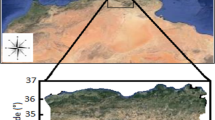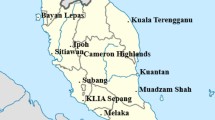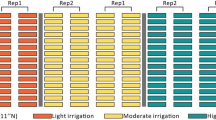Abstract
Nowadays, climate change is one of the numerous factors affecting the agricultural sector. Optimising the usage of natural resources is one of the challenges this sector faces. For this reason, it could be necessary to locally monitor weather data and soil conditions to make faster and better decisions locally adapted to the crop. Wireless sensor networks (WSNs) can serve as a monitoring system for these types of parameters. However, in WSNs, sensor nodes suffer from limited energy resources. The process of sending a large amount of data from the nodes to the sink results in high energy consumption at the sensor node and significant use of network bandwidth, which reduces the lifetime of the overall network and increases the number of costly interference. Data reduction is one of the solutions for this kind of challenges. In this paper, data correlation is investigated and combined with a data prediction technique in order to avoid sending data that could be retrieved mathematically in the objective to reduce the energy consumed by sensor nodes and the bandwidth occupation. This data reduction technique relies on the observation of the variation of every monitored parameter as well as the degree of correlation between different parameters. This approach is validated through simulations on MATLAB using real meteorological data-sets from Weather-Underground sensor network. The results show the validity of our approach which reduces the amount of data by a percentage up to 88% while maintaining the accuracy of the information having a standard deviation of 2\(^{\circ }\) for the temperature and 7% for the humidity.











Similar content being viewed by others
References
Ojha T, Misra S, Raghuwanshi NS (2015) The state-of-the-art in practice and future challenges. Wireless sensor networks for agriculture. Comput Electron Agric 118:66–84
Díaz SE, Pérez JC, Mateos AC, Marinescu M-C, Guerra BB (2011) A novel methodology for the monitoring of the agricultural production process based on wireless sensor networks. Comput Electron Agric 76(2):252–265
Musaazi KP, Bulega T, Lubega SM (2015) Energy efficient data caching in wireless sensor networks: a case of precision agriculture. In: Nungu A, Pehrson B, Sansa-Otim J (eds) e-infrastructure and e-services for developing countries AFRICOMM 2014. Lecture Notes of the Institute for Computer Sciences, Social Informatics and Telecommunications Engineering, vol 147. Springer, Cham. https://doi.org/10.1007/978-3-319-16886-9_16
Christian S, Nathalie M (2020) Machine learning based data reduction in WSN for smart agriculture. In: Advanced information networking and applications, Cham
Tayeh GB, Makhoul A, Laiymani D, Demerjian J (2018) A distributed real-time data prediction and adaptive sensing approach for wireless sensor networks. Perv Mobile Comput 49:62–75
Bermudez-Edo M, Barnaghi P, Moessner K (2018) Analysing real world data streams with spatio-temporal correlations: entropy vs. Pearson correlation. Autom Constr 88:87–100
Radhika S, Rangarajan P (2019) On improving the lifespan of wireless sensor networks with fuzzy based clustering and machine learning based data reduction. Appl Soft Comput. https://doi.org/10.1016/j.asoc.2019.105610
Habib C, Makhoul A, Darazi R, Salim C (2016) Self-adaptive data collection and fusion for health monitoring based on body sensor networks. IEEE Trans Ind Inf 12(6):2342–2352
Toldov V, Clavier L, Loscrí V, Mitton N (2016) A thompson sampling approach to channel exploration-exploitation problem in multihop cognitive radio networks. In: IEEE personal, indoor, and mobile radio communications (PIMRC)
Salim C, Makhoul A, Darazi R, Couturier R (2019) Similarity based image selection with frame rate adaptation and local event detection in wireless video sensor networks. Multimed Tools Appl 78(5):5941–5967
Tayeh GB, Makhoul A, Perera C, Demerjian J (2019) A spatial-temporal correlation approach for data reduction in cluster-based sensor networks
Razafimandimby C, Loscri V, Maria Vegni A, Aourir D, Neri A (2017) A Bayesian approach for an efficient data reduction in IoT. In: International conference on interoperability in IoT (InterIoT)
Razafimandimby C, Loscri V, Vegni AM, Neri A (2017) Efficient bayesian communication approach for smart agriculture applications. In: IEEE vehicular technology conference (VTC-Fall)
Azaza M, Tanougast C, Fabrizio E, Mami A (2016) Smart greenhouse fuzzy logic based control system enhanced with wireless data monitoring. ISA Trans 61:297–307
Ghaddar A, Razafindralambo T, Simplot-Ryl I, Tawbi S, Hijazi A (2010) Algorithm for data similarity measurements to reduce data redundancy in wireless sensor networks. In: A world of wireless, mobile and multimedia networks (WoWMoM)
Mou W, Liansheng T, Naixue X (2016) Data prediction, compression, and recovery in clustered wireless sensor networks for environmental monitoring applications. Inf Sci 329:800–818
Aya A, Oussama G, BenSalah MS, Mohamed A (2020) Spatio-temporal correlations for damages identification and localization in water pipeline systems based on wsns. Comput Netw 171:107134
Rajesh G, Ashvini C (2019) Correlation analysis and statistical characterization of heterogeneous sensor data in environmental sensor networks. Comput Netw 164:106902
Zhao H, Yang H, Wang Z (2016) Optimization of rainfall sensor network layout based on the correlation coefficient method. In: 2016 International conference on artificial intelligence: technologies and applications. Atlantis Press
Almeida FR, Brayner A, Rodrigues JJPC, Maia JEB (2017) Improving multidimensional wireless sensor network lifetime using Pearson correlation and fractal clustering. Sensors 17(6):1317
Shen Y, Guo J, Liu X, Kong Q, Guo L, Li W (2018) Long-term prediction of polar motion using a combined ssa and arma model. J Geod 92(3):333–343
Ding F, Meng D, Dai J, Li Q, Alsaedi A, Hayat T (2018) Least squares based iterative parameter estimation algorithm for stochastic dynamical systems with ARMA noise using the model equivalence. Int J Control Autom Syst 16(2):630–639
Khushboo J, Arun A, Anoop K (2021) A novel data prediction technique based on correlation for data reduction in sensor networks. In: Bansal P, Tushir M, Balas VE, Srivastava R (eds) Proceedings of international conference on artificial intelligence and applications, pp. 595–606. Springer, Singapore
Qing X, Niu Y (2018) Hourly day-ahead solar irradiance prediction using weather forecasts by lstm. Energy 148:461–468
Marchi E, Vesperini F, Weninger F, Eyben F, Squartini S, Schuller B (2015) Non-linear prediction with lstm recurrent neural networks for acoustic novelty detection. In: International joint conference on neural networks (IJCNN)
Shi X, Chen Z, Wang H, Yeung D-Y, Wong W, Woo W (2015) Convolutional LSTM network: a machine learning approach for precipitation nowcasting. In: Proceedings of the 28th international conference on neural information processing systems—volume 1, NIPs’15, Cambridge, MA, USA
Shu T, Chen J, Bhargava VK, de Silva CW (2019) An energy-efficient dual prediction scheme using LMS filter and LSTM in wireless sensor networks for environment monitoring. IEEE Internet Things J 6(4):6736–6747
Abdullah J, Hussien MK, Alduais NAM, Husni MI, Jamil A (2019) Data reduction algorithms based on computational intelligence for wireless sensor networks applications. In: 2019 IEEE 9th symposium on computer applications industrial electronics (ISCAIE), pp 166–171
Cheng H, Xie Z, Shi Y, Xiong N (2019) Multi-step data prediction in wireless sensor networks based on one-dimensional CNN and bidirectional LSTM. IEEE Access 7:117883–117896
Acknowledgements
This work was partially supported by a grant from CPER DATA and by LIRIMA Agrinet project.
Author information
Authors and Affiliations
Corresponding author
Additional information
Publisher's Note
Springer Nature remains neutral with regard to jurisdictional claims in published maps and institutional affiliations.
Rights and permissions
About this article
Cite this article
Salim, C., Mitton, N. K-predictions based data reduction approach in WSN for smart agriculture. Computing 103, 509–532 (2021). https://doi.org/10.1007/s00607-020-00864-z
Received:
Accepted:
Published:
Issue Date:
DOI: https://doi.org/10.1007/s00607-020-00864-z




